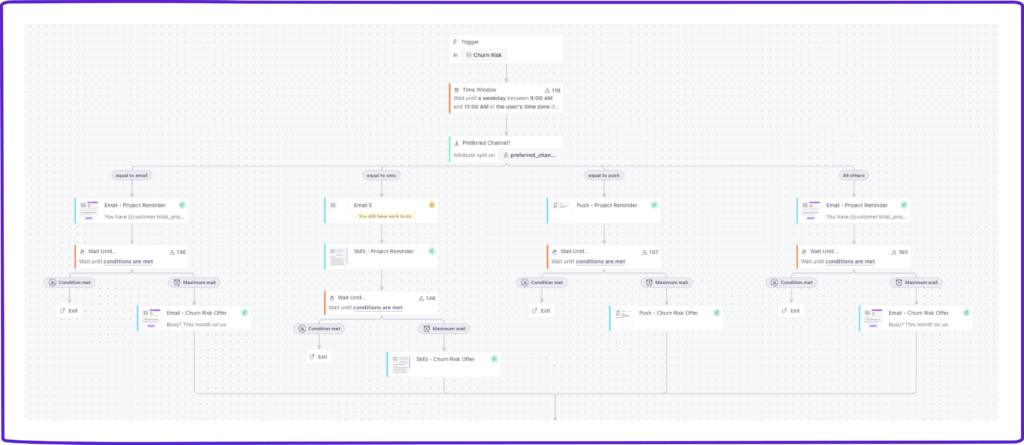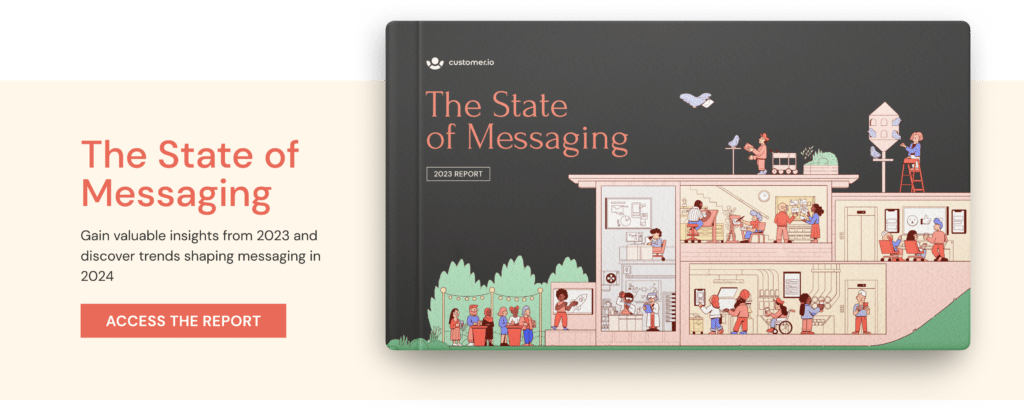
How to create a mobile marketing strategy: 9 tips for success
Before every household had a computer and every consumer had a phone, brands had to rely on broad marketing efforts to reach their audiences. A TV ad during a popular TV show, a billboard on a busy street…old-school tactics got a brand’s message in front of millions of eyeballs. But often, only a tiny percentage of those people were actually interested, motivated buyers.
Now, with mobile phones in every pocket, you can target your specific customer base—and even personalize content to each person’s unique interests. This makes having a mobile marketing strategy extra important for your business; every phone is like a tiny digital billboard for broadcasting tailored messages to your audience.
As a result, brands are leaning into mobile marketing strategies more than ever. According to the State of Messaging Report, companies across the globe increased their use of every mobile channel in 2023; we saw year-over-year increases of 47% for SMS, 49% for push notifications, and 187% for in-app messages.
Most interesting of all? Our research surfaced three particularly important trends shaping mobile marketing today: personalization, customer data, and multi-channel messaging.
In this post, we’ll cover three ideas for capitalizing on each trend, plus tips for putting each into action:
Mobile marketing strategy: Make it personal
Mobile marketing isn’t new, but it’s only recently that mobile marketing strategies have moved from “blast our whole customer list” to providing personalized experiences. In fact, 81% of brands surveyed for our State of Messaging Report said personalization is important in their messaging strategies—and 73% say they plan on increasing their personalization efforts in 2024.
Unlike those good old-fashioned billboards, mobile messages can be targeted at specific segments and customized for each person using customer data. Strategic marketers use this data to provide everything from personalizing mobile onboarding to asking for feedback, celebrating milestones, and providing tailored content. Instead of shouting into the void, marketers talk directly to their customers.
Pro tip #1: Segment your audience
No matter how you slice it, highly relevant messages make more of an impact. That’s where the power of segmentation comes in. Divide your audience into groups based on demographics, behaviors, product preferences, or any other attributes.
Here are just a few examples of segmentation in action:
- New customers: send onboarding campaigns to encourage rapid adoption
- Loyal customers: send referral campaigns to help them become brand evangelists
- Dormant customers: send reactivation campaigns to bring them back into the fold
- Customers who use just one of your products: send cross-sell campaigns to connect them to other products you offer
Recommended reading: 5 ways Hunter amps up engagement with segmentation
Pro tip #2: Reach people at the right time—in their time zone
A truly personalized message goes beyond inserting a bit of demographic info; it thoughtfully caters to each person’s circumstances. A small but powerful way to enact this is to customize messages based on time zones.

Let’s say you have a ticketing app and send concert announcements based on customers’ previous purchases. Imagine one customer, Cam, bought tickets to a Bruce Springsteen show last year, and The Boss has a new tour coming up. You might send them the following push notification:
Ready to rock out, Cam? New dates for the Bruce Springsteen tour were just announced—tickets go on sale tomorrow at 9:00 a.m. Eastern!
First name? Check! Relevant to their interests? Check! But wait, Cam lives on the West Coast—so now they have to do the math to figure out when they can snap up seats. That’s more friction getting in the way of engagement and a lost opportunity to personalize your mobile marketing strategy fully.
Pro tip #3: Open a convo with in-app surveys
Want to create a mobile marketing strategy that really connects? Make it a two-way street. With in-app surveys, you can collect real-time feedback from your customers. This has the dual benefit of gathering more valuable data you can use to customize messages and provides customers with an outlet to make their voices heard.
Tailor your surveys based on people’s behavior, such as asking for feedback about a feature after a customer uses it for the first time.

Mobile marketing strategy: Embrace your data
The power of personalization lies in using customer data to its fullest potential. You have a wealth of information about your customers—from zero-party data comprised of info they proactively share to first-party data you collect about their behaviors. But when data isn’t centralized, it’s hard to make it useful: you wind up with lots of numbers and little insight.
As the State of Messaging Report points out, over half of brands still struggle with data quality issues and a lack of a unified customer view. The investment in tools for collecting, analyzing, and activating data will make or break mobile marketing strategies now—and in the future.
Pro tip #4: Unify data with a customer data platform (CDP)
Using a customer data platform (CDP), you can pull in data from across every touchpoint to fully understand your customers. With a cohesive view of each individual, you can then send and activate data to every tool in your martech stack. Bonus? A CDP enables you to deploy that customized content in real time, reacting immediately to customer actions.
Remember the billboard? All the information you have to work with is roughly how many cars drive by on any given day and what landmarks are nearby. But with a mobile marketing strategy powered by a CDP, you can know a lot more than that— like what content people engage with, where they’re located, and what products they’ve purchased in the past. Now, you can segment your audience and target them with messaging you know will resonate.
Recommended viewing: Unlock your data for more personalized & impactful campaigns [Webinar]
Pro tip #5: Use mobile SDKs for in-app messaging
Mobile SDKs save developers time and empower marketers to access customer data for targeted messaging. When you know what screens they visit, the features they use, and how long they stay in your app, creating messaging relevant to what customers are doing in real time is easy.
Here are some example in-app messages you might send:
- Version update reminders: send an in-app message reminding someone to update to the latest version upon opening your app
- Subscription renewals: display an in-app banner reminding customers of their upcoming subscription renewal when they view their billing history
- Feature highlights: use in-app inline messages to offer a walk-through when someone tries a feature for the first time
Pro tip #6: Take advantage of analytics integrations
Metrics are incredibly valuable for understanding and optimizing your mobile marketing strategy—but only if the data is presented in a way that provides actual insight. That’s why many CDPs (including Customer.io’s Data Pipelines) integrate with third-party data analytics platforms like Mixpanel and Amplitude.
You can use these integrations to dive deep into your customers’ behaviors, identify when engagement hits the sweet spot (or falls off a cliff), and refine your mobile marketing strategies with ongoing iteration. And if your analytics platform doesn’t directly integrate with your messaging automation platform, you can send and receive data with webhooks to connect them.
Mobile marketing strategy: Connect across channels
Email has long been the cornerstone of outbound marketing, and it remains significant even as brands begin implementing mobile marketing strategies. But the most effective approach is combining multiple channels to create a seamless, holistic experience for your customers. In fact, our data shows that multi-channel campaigns perform 63% better than single-channel campaigns, with the combination of email, SMS, and push proving to be especially effective.
Pro tip #7: Create an omnichannel experience
When you create a mobile marketing strategy, it’s easy to fall into the trap of looking at each channel individually. But that’s not how your customers experience your brand. For them, every interaction is part of a holistic journey, and it needs to feel cohesive. So shift your thinking to omnichannel marketing: creating a unified experience across every touchpoint, from email to SMS, push, and in-app messaging—as well as your website, social media, and every other place you show up in customers’ lives.

For example, you could send a follow-up email to customers who opened an in-app message but didn’t convert right away. You’re now touching them on two separate channels and bringing those two experiences together. Similarly, say a customer starts adding their billing information in-app but exits before finishing. You might send a push notification a couple of hours later to bring them back; if they still don’t complete the action, you could deliver an email the next day with step-by-step instructions.
Pro tip #8: Consider the customer’s context
A billboard has no context except for the street it’s on. It can’t consider a customer’s unique experience, what they want to achieve, or what time of day they’re driving by. Don’t approach your mobile marketing strategy like a billboard; treat it like a human-to-human relationship. Pay attention to when customers are most likely to interact with your brand and how they’ve engaged in the past.
For example, say you have a project management platform for businesses. Saturday afternoon is the last time people want to think about work, so save your mobile marketing messages for weekdays during work hours. And consider the context of different channels. SMS and push notifications are, well, a bit pushy. Time-sensitive or particularly important info may be welcome in those channels, but you’ll annoy people if you bombard them with non-pressing nudges.
Pro tip #9: Maintain consistency across channels
It’s off-putting for customers when inconsistency is coming from a brand. Consistent messaging, colors, fonts, and brand voice is critical to present a uniform brand experience across every channel, from in-app to email. Having one tool to manage all your messaging makes a big difference here; when you use one tool for in-app messaging and another for email, it’s easy to create a disconnected customer experience.
Of course, the level of customization you can do will vary among messaging platforms. Make sure the tool you use allows you to edit colors, fonts, and images to match your branding so it feels like a seamless branded experience. This helps build trust, drive engagement, and make you more memorable to your customers.
Ready to evolve your mobile marketing strategy?
When you put up a billboard, you’re certainly delivering a message. But you can’t guarantee it’s the right message at the right time—or if you’re even reaching the right person. With a multi-channel mobile marketing strategy powered by customer data, you can reach people with personalized messages at the exact time and place they’re ready to engage.
With Journeys, you have the power to build relationships with a cohesive, omnichannel strategy across email, SMS, push, and in-app—with messages that convert in the moment and keep customers coming back over the long term. Start your free 14-day trial today.
